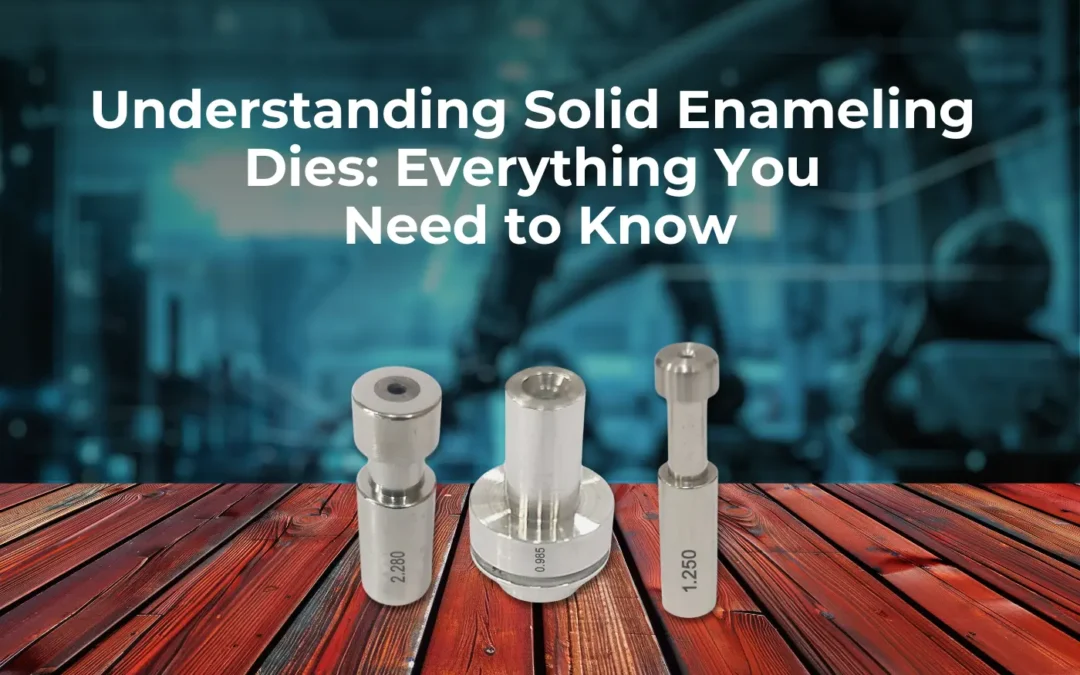In the world of wire manufacturing, solid enameling dies play a key role in ensuring high-quality finishes for enameled wires. Whether you’re working with steel, aluminum, or brass, these dies are essential for creating smooth, defect-free wire surfaces. But what exactly are solid enameling dies, and how do they work? Let’s dive into the details.
1. What Are Solid Enameling Dies?
Solid enameling dies are specialized tools used in wire manufacturing to coat wires with enamel. These dies come in various materials, such as PCD (Polycrystalline Diamond), natural diamond, and tungsten carbide, each offering different properties tailored for specific applications. The wire diameter range for these dies typically spans from 0.200 mm to 6.00 mm, allowing for versatility across various industries.
Solid enameling dies ensure an even enamel coating on the wire surface, essential for industries like electronics and manufacturing, where consistent insulation is required for magnet wires. The design of these dies is precise, ensuring that each wire that passes through is coated uniformly without any blisters or pinholes, which are everyday issues that impact wire performance and durability.
2. The Importance of Precise Die Geometry
The most important feature of solid enameling dies is their mirror-polished geometry. This design guarantees that the enamel flows smoothly and frequently over the wire, essential for maintaining the quality of the wire’s surface. Any flaws in this flow can lead to uneven coating, resulting in potential failure in applications where insulation is crucial.
The internal body design of these dies is equally essential. The internal structure ensures that there are no interruptions or imperfections in the coating process. This is the primary reason why accurate size and precise die geometry are robust features in manufacturing solid enameling dies.
3. Customization for Different Machines
Not all wire manufacturing equipment is the same. Some use vertical coating machines, while others depend upon horizontal machines. Solid enamel dies can be personalized to fit any set-up, ensuring that they meet the specific requirements of every single customer. The dies can be customized to machines ‘ specifications, whether working with steel, aluminum, or brass wire bodies.
This range of customization goes beyond just the machine type and includes special applications. The designing team works closely with clients to understand their specific needs, whether that involves modifying the die’s profile or using a particular material for the die’s body. It ensures every customer receives a product tailored to the unique manufacturing processes.
4. Why the Material of the Die Matters
Solid enamel dies are made from PCD, natural diamond, or tungsten carbide tips. Each of these materials has specific benefits:
- PCD (Polycrystalline Diamond): Known for its extreme hardness and resistance to wear, PCD is mainly used in high-precision applications where die durability is a priority.
- Natural Diamond: Natural Diamon dies offer unparalleled smoothness and wear resistance, making it the ideal choice for applications needing the highest surface quality.
- Tungsten Carbide: While not as hard as diamond, tungsten carbide offers excellent longevity and is used in less demanding applications where cost-effectiveness is a concern.
The choice of material depends on the specific needs of the coated wire and the machine used in the process.
5. Ideal for High-Speed Operations
Solid enameling dies are not just about precision; they are designed for speed. In wire manufacturing, productivity is mostly measured by how fast machines run without compromising quality. These dies are ideal for operations with a VD factor of up to 100, allowing for high-speed production while maintaining enamel coating quality.
6. Reconditioning and Repolishing Services
Even the best solid enameling dies will gradually wear out, particularly in high-speed and high-volume operations. Many manufacturers offer reconditioning and repolishing services to expand the life of these precious tools. It ensures that even worn-out dies can be restored to their best performance, reducing downtime and manufacturing costs.
Repolishing is essential for maintaining the die’s mirror-polished surface, which ensures a smooth enamel flow and prevents imperfections like pinholes and blisters on the wire.
7. The Role of Solid Enameling Dies in the Wire Industry
Solid enameling dies are essential in the electronics, automotive, and telecommunications industries. These wires require longevity and precise insulation, where the enamel coating quality is crucial. A reliable enameling die ensures wires perform exceptionally in transformers, motors, or other critical applications.
8. How Solid Enameling Dies Support Sustainable Manufacturing
As industries move towards more sustainable practices, durable, high-quality dies become even more crucial. By using durable and robust materials like PCD and tungsten carbide, manufacturers can reduce the frequency of die replacements, resulting in low waste and more proficient production processes. Additionally, reconditioning services extend the lifespan of these dies, further contributing to sustainable manufacturing practices.
Conclusion:
Solid enameling dies may be a minor component in wire manufacturing, but their importance in the finished result cannot be overstated. Whether you require precision, durability, or speed, these dies provide a solution that matches modern industrial needs. Manufacturers who invest in high-quality solid enameling dies can ensure that their wires are functional and of the finest quality, making them perfect for use in today’s fast-paced industries.
For organizations trying to improve their wire manufacturing processes, it is wise to partner with a firm that provides customized solid enameling dies and reconditioning services. It ensures quality, consistency, and a commitment to environmentally friendly, efficient production.

